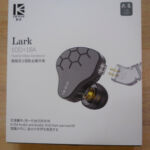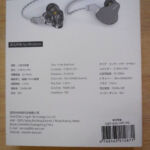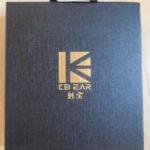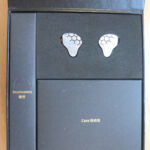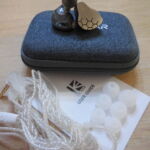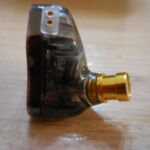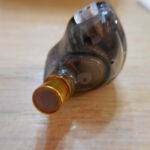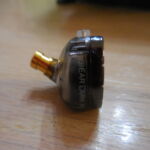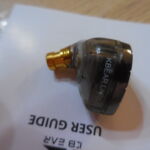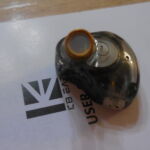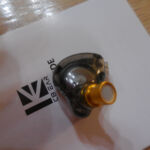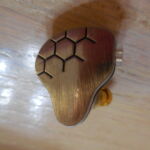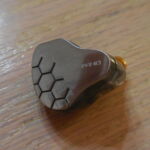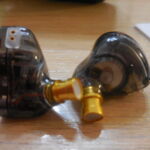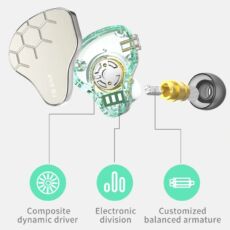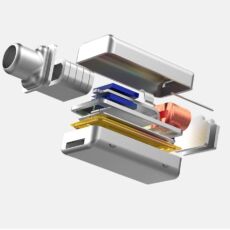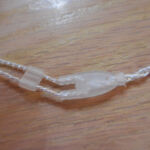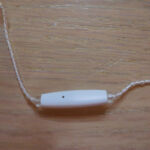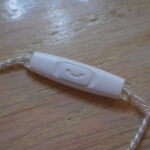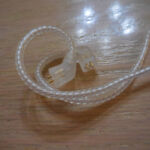KBear Lark
disclaimer: The KBEar Lark was sent to me by HifiHear for purposes of this review. I have no financial interest in HifiHear or KBEar, nor have I received any compensation or guidance regarding the content of this review. If you have an interest in purchasing the Lark, visit HifiHear on Amazon.
Unboxing / Packaging:
The Lark comes in a slipcover style outer box with a bookfold inner box. The outer cover has a photo of the Earpiece on the front along with KBear’s name, model name, slogan, and some basic details. The reverse has more complete details in both Chinese and English. When the cover of the inner box is lifted the contents are split into 3 compartments; a narrow full height box on the left, and two wider boxes arranged one over the other to the right. The narrow box has the cable and tips, while the top compartment displays the earpieces and the lower hides the case and manual. 4 sets of tips are provided along with the case, cable, and manual. My sample did not come with cable ties, shirt clips or other accessories but at <$30 right now, the inclusion of a case is an often missing accessory.
Build/Fit:
The Lark is a hybrid shell with a resin inner shell, metal face plate, and brass nozzle. Seams are well done with no gaps, glue, or irregularity and are harder to feel than most at this price point. Shape is the fairly common inverse teardrop and it is about average size but thinner than average. The bi=pin connector is the raised squared type so QDC connectors with rounded edges will not fit flush and should be avoided. A single vent exists on the inner shell directly over the center of the dynamic driver which is easily visible through the transparent inner shell. Nozzles have a lip for tip retention and a forward and upward rake allowing for fairly deep insertion and better isolation as a result. The Lark was comfortable in ear for long listening sessions with no physical fatigue or points of discomfort.
Internals:
Inside the Lark, we find a hybrid arrangement with a single 10mm dynamic driver with a bio-composite diaphragm and a custom tuned balanced armature that appears to be based on the 30019. Nominal impedance is listed as 16Ω with a sensitivity of 105 dB/mW. The numbers suggest this should be easy to drive and I found it worked very well with low powered sources and didn’t need an external amp when paired to a phone or tablet. The Lark may actually be a bit better at lower volumes or with lower powered sources as potent sources with high gain tended to cause noticeable distortion (particularly in the bass).
Cable:
The cable is typical of budget offerings and differs little from standard fare. It starts at the low end with a 90º 3.5 Jack (TRRS for the mic in this case) in plastic housing with no strain relief on exit. The cable itself is a double twist with 4 strands first paired as twists, then twisted together in the the opposite direction to form the cable. The wire itself is the now standard silver coated copper. The splitter is the familiar plastic Y shape again with no strain relief below the splitter but short reliefs above it. A chin slider is provided which is a nice touch as these are often omitted on cables with remotes. Unfortunately, with the splitter as low on the wire as it is, you’ll need the chin slider. The north end has pre-formed hooks and hooded .78mm bi-pin connectors again in matching translucent plastic housings. They do have R/L on the connector but it is hard to see in some light. Typically the Mic/remote is right side which makes it easy if you have a remote but without one indexing may take a minute. The mic/remote is a single button design with the mic opposite the button. I found it worked well enough for phone calls but was susceptible to ambient noise and movement. I traded the cable out for measurements as the mic does cause some channel imbalance as well.
Sound:
Bass:
Mids:
The mids do step back slightly but not enough to feel recessed or distant so rather than call them that I will go with UN-emphasized. Lower mids have good weight and male vocals are solid without feeling artificially weighted. Guitar growl is acceptably sharp-edged, and lower strings have good tonality as well. True mids are equally well done with strings being well voiced and nearly natural. Upper mids are pushed forward a bit and plateau out at roughly the same level as the bass emphasis. This emphasis does push female vocals to the front by a full step and is just slightly more than needed for realistic string reproduction (but its close). Overall, as a lover of mids, I found a lot to like about the Lark and if there is one caveat it is don’t expect the level of detail out of it you’ll get with a higher spend. Its well better than $30 should deliver, but its not a giant killer that will replace your A7s or ESRs.
Treble:
Lower treble starts on the same plateau with the upper mids and while emphasized is very smooth with no big dips or spikes that would make it quickly fatiguing or strident. The lower treble does carry enough energy to give the Lark a slightly bright tone but won’t be enough to scare the treble shy among us. There is a step back above about 5kHz that keeps the Lark from getting overly aggressive but snare rattle is still quite believable and cymbals are rendered better than anticipated at this budget. Roll-off is above the limits of my hearing and better than a lot of the budget offerings I’ve tried lately as it gives the Lark a nice open top end with good air and enough sparkle to feel realistic but not so much as to quickly fatigue the listener. Treble detail is also quite good as the BA delivers more detail and even micro-detail than many at this price point.
Soundstage / Imaging:
Stage is wider than deep but has enough depth to keep it from sounding abnormal. Height is good as well and while I’d stop short of using terms like holographic and 3d it again does well better than one should expect at the price. Seating the orchestra is straight forward as long as listening volume is kept reasonable but breaks down a little at high volume (particularly on the lower voices). This is partially because the layering on the dynamic struggles a bit at high volume with very dense passages and distortions start creeping in. Imaging is quite good with movements fairly precisely positioned and tracked around the space.
Thoughts / Conclusion:
I have to admit, I’m getting old and jaded and look at most new budget offering with mixed emotions. Sure, I need blog fodder, but do I really want to put in the effort of 40 hours of listening, a day or two of writing and editing and another of taking care of images, links, and promotion for what amounts to another in the endless stream of sameness? Having recently been supremely disappointed by a couple KZ offerings, the arrival of another metal outer / resin inner hybrid did little to get me excited. But then I put them in my ears and things changed quickly. They were not the standard cavernous V with the treble chopped off neatly at 9kHz. They had mids, good ones. Bass had some control and tone and was just loud. It was almost like someone had taken time to tune these. Could it be? A budget maker that actually cared what they put out and wasn’t trying to just push out another new model for sake of doing so? It sure seems so. KBear’s Lark has their best signature to date in a comfortable shell and at a great price. I like the KB04 shell a bit better, but the signature of the Lark is more balanced and has better mids. For $30, these will make a great stocking stuffer for those on your list, just be sure to get one pair for yourself too.
-
Bass - 7.5/107.5/10
-
Mids - 7/107/10
-
Treble - 7/107/10
-
Soundstage - 6.5/106.5/10
-
Imaging - 7/107/10
Summary
Pros: good balance, detail, and near neutral signature, well built, good kit
Cons: Cable average at best, mic picks up wind and ambient noise


